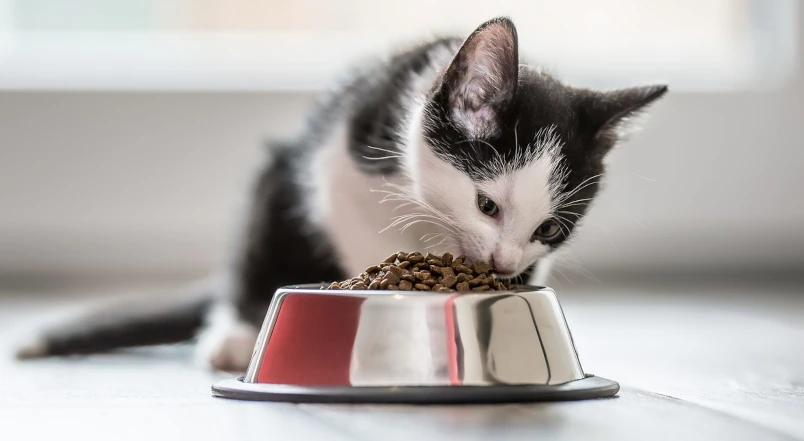Introduction
Cat food , how to choose?
The dog and the cat are mammals belonging to the order of carnivores . Although both have a diet based on animal proteins , due to evolutionary characteristics the cat is defined as a “strict carnivore “. It is possible to note how the feline dentition is not designed for effective chewing of foods of vegetable origin and its intestine is shorter than in humans or herbivorous animals, therefore specific for very rapid digestion .
Components of cat food
A cat’s diet must meet the specific energy needs of the species and the stage of life in which the individual is located, from the growth stage of the kitten, to adult life, up to old age. Each phase of the cat’s life constitutes a change in the amount of energy necessary to maintain constant body temperature and organ functions, as well as specific moments such as pregnancy and lactation.
Therefore, some components of the diet assume great importance, which are metabolized for the production of energy and essential substances for the body:
- Protein
They can be divided into simple proteins , if formed by amino acids alone , or complex proteins, if associated with other molecules. They are involved in the constitution of organs and systems, they can have a hormonal function , the maintenance of the acid-base balance or of the components of the immune system . Some amino acids are more important because they are defined as essential: these cannot be produced by the body, but must be introduced in the diet. In cats there are 11 essential amino acids including arginine and taurine. For this reason, the amount of protein that cats need is higher than other animals, reaching minimum quantities of 25 g / 100g of product for adult cats or 28-30 g / 100g of product for growing and breeding cats.
- Fats
They are the primary source of energy and, thanks to the large bile production , carnivores are able to make the most of them. For this they can be part of the diet up to 15-30%.
Particular attention is paid to the components of the food which provide omega -3 and omega-6 fats , including linoleic acid , arachidonic acid , DHA and EPA .
- Carbohydrates
They are the main energy components of vegetables and are important for the proper functioning of the intestinal tract, in the form of fibers , and for the structure of numerous organs in conjunction with proteins and fats. Carbohydrates can be formed from protein metabolism or taken directly from the diet , which becomes fundamental in periods of the animal’s life in which the amount of energy required increases, such as growth, pregnancy or breastfeeding . Starch is the main carbohydrate found in cereals and potatoesand is used in the extrusion phase of the croquettes, thus becoming highly digestible for dogs and cats and allowing a better availability of proteins for the body.
Among carbohydrates we also find fibers , with important functions for intestinal well-being . The fibers can be soluble and fermentable with the action of decreasing intestinal transit and faecal mass , or insoluble. The latter, with their action of retaining more water in the food and decreasing its absorption, can be useful in some intestinal pathologies. In recent years, pre-biotic fibers have gained importance, capable of supporting the growth of “good” bacteria rather than pathogenic ones. Among the pre-biotic fibers we find fructo-oligosaccharides ( FOS ) and mannan- oligosaccharides (MOS).
- Vitamins
They are organic molecules necessary for the body in small quantities, but indispensable for the growth and functionality of the organs. They can be divided into fat-soluble vitamins (A, D, E, K) and water-soluble vitamins ( vitamin B complex and vitamin C ). The first group has the ability to be accumulated, so today it is more common to find an excess of these compared to the others. Sources of vitamins are meat, fish , eggs , milk , citrus fruits and legumes . A lack of vitamins leads to specific manifestations for each one.
- Minerals
They are inorganic elements important for the body’s metabolism and can be divided into macro-elements ( calcium , phosphorus , magnesium , sulfur , sodium , potassium and chlorine ) present in greater quantities, and micro-elements (such as zinc , iodine , manganese ..). Some minerals are linked together by balances of absorption, metabolism and activity, such as for calcium and phosphorus .
How to choose food
There are countless foods on the market for cats, both wet and dry food. The choice of food suitable for our cat must take into account some basic elements to ensure that it is kept healthy, with adequate quantities available.
- First of all, the choice must fall on a complete and balanced food , which therefore follows an adequate supply of nutrients with the correct quantity for the animal’s life stage.
- As a second evaluation, one must find a food that is palatable . Unfortunately, the cat does not have a criterion for choosing in eating the food that will be better at a nutritional level, but rather the one that attracts him the most in terms of taste and smell. It is therefore the owner who must put the two elements together in order to offer good food to his pet, and that this can be eaten safely without forcing.
- Finally, the digestibility of the product must be considered : this characteristic influences the real availability of the food for the body, which must be able to absorb the nutrients and transform them. In fact, non-digestible food will lead to the production of malformed feces, diarrhea, gas production and fermentation due to an altered digestive mechanism by intestinal bacteria.
It is possible to find the three fundamental elements described above in many commercial products. Dry foods are distinguished from wet foods by the amount of water present; in fact, the humidity ranges from 6-10% for croquettes to 75% for tins. This datum influences the quantity of product that the cat must take in order to have a total daily ration and the quantity of water taken up through watering. Croquettes, having a lower intrinsic quantity of water, stimulate the animal’s thirst more and allow him to assume a typical feeding behavior of the species. The cat usually prefers to eat a little several times a day, even taking 10/15 meals a day. For this reason, dry food is more suitable for maintaining quality and composition than wet food, especially in summer. However, it is not excluded from
If you prefer to cook for your cat, you must not neglect the three fundamental factors for building a balanced, palatable and digestible diet . The advice therefore is to have the right composition indicated by your veterinarian to arrive at a home diet suitable for health and the prevention of future pathologies.
Finally, in pet food stores you can find specific veterinary diets that can be prescribed directly by the doctor treating your cat for the treatment of pathologies that afflict him. In this case it is necessary to follow the diet prescribed by composition and quantity in order to be able to have an expected medical result.
Read the label
Every product released on the market, including pet food, must have some basic information on the packaging that describes it. There are numerous regulations that regulate mandatory and optional information to be indicated, but the main reference is given by EC Regulation 767/2009 which regulates the adequate labeling of feed placed on the market and the minimum information that the consumer must receive.
Analyzing a cat food the parts of the label to pay attention to are:
- Typology : this is mandatory information andallows you to understand if the food is complete or complementary. The difference in classification is given by the quantity of elements present in the food and by the conditions of use. In fact, a complete food contains all the nutrients necessary for the animal’s diet, theoretically without the need for additions. A complementary food, on the other hand, is lacking in some parts and is generally given by a smaller quantity of ingredients. Usuallywetfoods are part of the second category due to the processing that the raw materials must undergo for production. A diet based on complementary foods is therefore poor and can lead to nutritional deficiencies.
- Composition : indicates the ingredients of the food, which can be listed in two ways. The description of the individual raw materials present (e.g.chicken,rice,carrots..)is called anopen formulaclosed formulafor the description of the categories of raw materials (e.g.meat,vegetables..). The order of the ingredients must follow theweightdescending, even when the ingredients are incorporated into categories, as in the closed formula. That way when commodities are spun off they could climb into the lower places of the list. This means that you have to pay attention to the type of formula used to understand which ingredient is most present.
- Analytical contents : these are the list of thepercentages of protein, fat, fiber and ash present. The humidity, therefore the percentage of water present, may also be indicated, but it is mandatory information only if higher than 14%. The comparison between two foods can take place if you look at the amount of analytes on the dry matter. This way you are not misled by theamount of wateror the caloric density of the food. We remind you that the evaluation of one food better than another must take into account the derivation of the analytes. A food with high amounts of protein is not always the best:animal proteinsare qualitatively better thanvegetable ones. Even a high amount of fiber generally makes the food less digestible, but if we check the label we see prebiotic fibers (such as beet pulp, chicory…) these can be useful for gastrointestinal well-being. Finally, the ashes are brought to the food through poor quality raw materials; its proportion to the protein content should not be high for a good quality food.
- Rationing tables : they do not form part of the mandatory information, but they are very useful for the owner to know the right amount of food to give to his pet. Generally the data that are presentconcern the age of the animal and the weight reached. It is important to remember that the quantity of food indicated always refers to the daily quantity, which must therefore be divided into programmed meals over 24 hours. In the case of cats, knowing your pet plays an important role. Ethologically, felines take small quantities of food in many meals during the day, but if you know you have a very greedy cat, rationing must be programmed so as not to risk overfeeding it.
A careful reading of the label therefore leads to a greater awareness of the purchase that is going to be made, but it must be remembered that this information must be cross-referenced with the reaction of the cat when we offer it to him.




